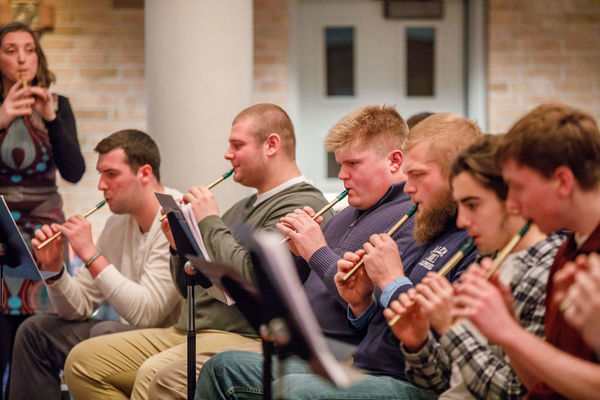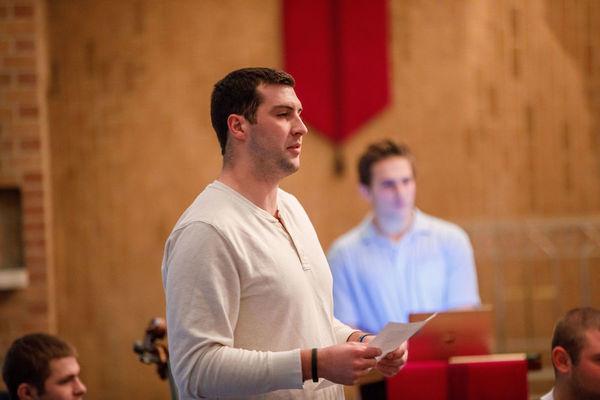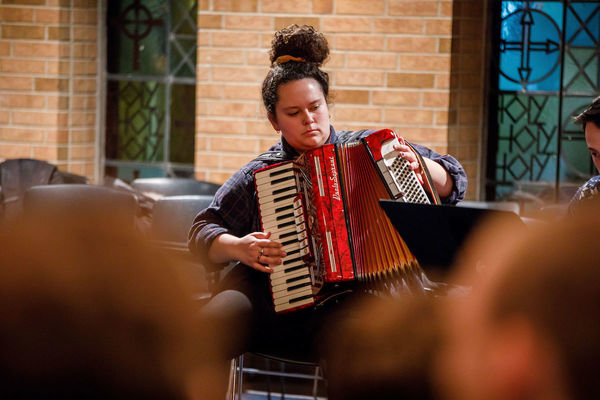When the typical Notre Dame student thinks of Irish music, what comes to mind?
On this campus, the home of the “Fighting Irish,” responses might include a traditional Irish fiddle tune, perhaps a U2 song, or even a Dropkick Murphys’ number.
But what Notre Dame students may not know is that the lyrics to a song they consider central to their identity was written by the 19th-century Irish composer Thomas Moore. Called ‘The Minstrel Boy,’ it was intended to commemorate Irish patriots who died during the 1798 Rebellion and then became associated with the Irish Brigade during the American Civil War. The song entered into the Notre Dame Band’s repertoire in 1999—and a ballad version of ‘The Minstrel Boy’ has been played ever since as the preamble to every Band rehearsal as well as at Football Friday march-outs in front of the Dome and during Game Day Concerts on the steps of Bond Hall.
 Aileen Dillane
Aileen Dillane
“The history of ‘The Minstrel Boy’ and its total incorporation into Notre Dame’s culture,” says Professor Aileen Dillane of the Irish World Academy of Music and Dance at the University of Limerick, “demonstrates perfectly that there are a myriad of ways in which ‘Irish’ music has been experienced, reimagined, and extended over two centuries in America. Music is absolutely central to discussions and representations of Irish and Irish-American identity.”
Teaching how to Best “Critically Encounter” Irish
Music in the U.S. – in a Myriad of Genres and Forms
Dillane, who received her doctorate in ethnomusicology from the University of Chicago (where she was a Century Fellow and Fulbright Scholar), visited the Keough-Naughton Institute for Irish Studies during the Fall 2017 term as the Herbert Allen & Donald R. Keough Visiting Faculty Fellow and Moore & Livingston Faculty Fellow.
It was a packed semester. She continued her research within the Irish Studies Collection of Hesburgh Library on the fieldwork, sound recordings, and publications of Captain Francis O’Neill from Chicago. She also wrapped up a co-edited book project, Songs of Social Protest, which features her own chapter on Dublin singer/songwriter Damien Dempsey along with 30 other chapters on protest songs from different historical eras and across the globe. And she guest-lectured in Irish Studies courses, presented within the Institute’s “Speakers and Public Talks Series” on the topic “Singing Protest in a Globalized World,” and was the organizing force for three performances of Irish music and dance on campus. Memorably, she performed herself—formally and informally here at Notre Dame, in Chicago, and in Michigan. With Dillane’s instruments the traditional flute, tin whistle, piano, and keyboards, she is a member of the All-Ireland winning Templeglantine Ceilí Band and a former member of the Chicago-based band Anish.

The undergraduate class Dillane taught, named Critical Encounters with Irish Music in North America: Performance, Text, and Context, was central to her semester-long visit here.
Every Monday and Wednesday, the 15 Notre Dame undergraduates enrolled in that class explored the place of Irish music in the United States—first as an immigrant music and then as a distinctly American take on what constitutes Irish music in both traditional and popular realms.
“Various genres of Irish music have been part of the global flow of music culture, people, and technology for over two centuries,” Dillane explains. “In the class, we worked to explore how expressive and generic tensions in various styles of Irish music pushed to become ‘American’ while also retaining a sense of being tethered to Ireland, whether that Ireland was real or imagined.”
Along the way, students learned about and discussed such concepts and themes as ethnicity, identity politics, colonialism, post-colonialism, and celticism, and then used musical pieces to illustrate and understand how these issues are negotiated and represented in musical form, as well as in musical discourses. By examining lyrics from 19th century Irish migrant songs, for example, the class explored very personal expressions dealing with emigrant experiences—a topic particularly relevant during the past fall semester, when the U.S. was embroiled in policymaking, court orders, and discussions on borders and immigration.
Students also explored repertoire from American Minstrelsy—as well as more Hollywood-oriented Irish nostalgic songs—to underscore, says Dillane, “how Irish and Irish American identity are constantly negotiated by different agents and are never neutral or benign. Even if Notre Dame’s Fighting Irish leprechaun is a much beloved mascot now, there were times, we learned, when such stereotypes carried very negative connotations.”
Notre Dame Undergraduates Become Musicians Themselves
 Mr. Pat Buckley, Limerick
Mr. Pat Buckley, Limerick
Simultaneously with their academic study of Irish music, the undergraduates became makers of music themselves. While some students entered the class already proficient on the piano, cello, guitar, or other instrument, everyone in the class was required to learn the tin whistle. Dillane had brought a box of tin whistles with her—procured from Mr. Pat Buckley, her local grocer in Templeglantine, Co. Limerick and also the drummer in her ceilí band —and handed them around the first week.
“My class was offered as an elective as well as a fine arts requirement,” Dillane explains, ”so I thought it important that students develop new skills. Playing the tin whistle is one such skill, and it also gave students the opportunity to perform from repertoires encountered in class that have a rich history while being relatively simple to learn and quite affective.”
Students used their tin whistles during class and, early on in the semester, two of them surprised and delighted the audience by joining in a rendition of ‘The Dawning of the Day’ (also a melody to the famous song ‘Raglan Road’) during a performance by Chicago musician Liz Carroll, an All-Ireland fiddle champion, Marty Fahey, an accomplished musician of the accordion and piano, along with Dillane on the flute. Consistent with the class’s emphasis on the context of Irish music, the musicians that night not only played music that they had composed or recorded for a groundbreaking exhibit at the Art Institute of Chicago on Irish artifacts but explained how they had functioned as the exhibit’s musical curators. They also brought in objects and photos to demonstrate how certain artifacts are important to Irish history.
And students’ reactions to the semester’s class?
Nicholas Weishar, a senior finance major from Chicago who also plays tight end for the Notre Dame football team, said that he enrolled in Critical Encounters with Irish Music “to learn more about Nic Weishar
Nic Weishar
how [elements of] the Irish culture managed to make its way to America.” He added: “I have enjoyed being able to practice the tin whistle all while still learning in a classroom setting. I have never had the opportunity to be in a class like this, and it has been a breath of fresh air.”
 Molly Burton
Molly Burton
Molly Burton, a senior triple majoring in Gender Studies, Peace Studies, and Philosophy, and an accomplished musician who has played traditional Irish music since the age of five, said that she was fascinated “to learn more about the historical context of the music I've always played and to realize the significance of the songs and tunes I play with my friends.”
Weishar, Burton, and other members of the class worked all semester towards a culminating moment: a performance on December 6th in the chapel of Stanford and Keenan Halls. That night, as members of The Fighting (and Sentimental) Irish Ceilí Band, the students presented a musical "showcase” that included such ballads as ‘Raglan Road, ‘Danny Boy,’ ‘The Minstrel Boy,’ and ‘The Fields of Athenry.’ The students chose the repertoire, wrote descriptions of the history and context of their musical selections, and, of course, played the music themselves.
In that night of music, two moments stand out.
One was when Stephen Luke Muldoon, originally from County Donegal but whose home is now Puerto Rico, performed a solo rendition of the famine song ‘The Fields of Athenry.’ For him, the song represented deeply felt sentiments about his Irish identity. Never before having sung in public, Muldoon’s gentle and heartfelt rendition to quiet guitar backing by Dillane was one of the hits of the night.
The other was a stirring rendition of ‘The Minstrel Boy,’ complete with a spoken verse, during which the students’ emotion was palpable.
“It was quite the moment when four members of the Irish football team—Lincoln Fiest, Ryan Kilander, Logan Plantz, and Nic Weishar—sat together in the front row and played 'The Minstrel Boy' on their tin whistles,” Dillane remembers. “All are members of the team for which the song is used as an introduction and as a rallying point. Now, they could perform it themselves—which they did with the same intensity, dedication, and enthusiasm they have brought to their sport for four years here at Notre Dame.”
Read more about Professor Aileen Dillane